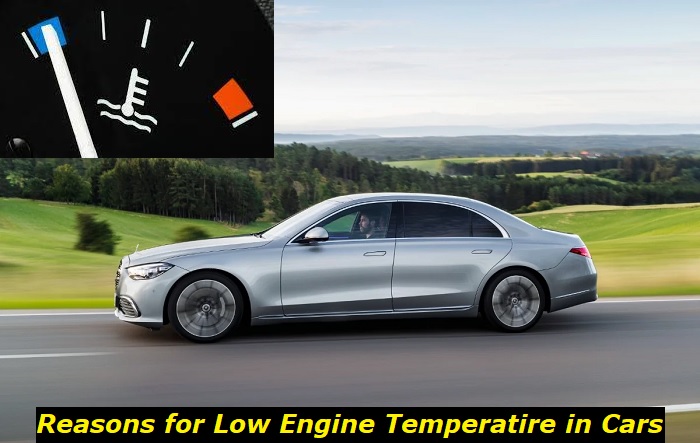Early in the morning, when you start your car on your way to work, the car's engine is usually as cold as the steering wheel. When you start the engine, the combustion process commences, and many engine parts are now in motion. The engine's temperature rises to an operational level when it is safe to drive and even turn on the AC.
Engine temp problems highlights
- Level of urgency:very high
- Commonreasons:low coolant, thermostat problems, coolant blockage, radiator fan problem
- DIY diagnostics:possible but complicated
- DIY repair:impossible
- Price of repair:$300 - $650
- Time for repair:3 - 6 hours
- If ignored:engine failure, low performance, cooling equipment damage

What causes low engine temperature?
1) Faulty temperature gauge
Old vehicles tend to have a lot of issues because of wear and tear. Many owners of old cars will assume it is the gauge that is faulty if the gauge stick doesn't ascend to the middle of the gauge. In fact, many drivers will tap on the gauge to check whether the bar got stuck and is unable to move freely within the gauge. Sometimes, the gauge will come to life when you tap on the instrument cluster, indicating that the temperature gauge is indeed faulty.
As stated above, the temperature gauge can become faulty, but this problem is more likely to be encountered in old automobiles. This problem can also happen if the gauges are incorrectly installed or when the necessary sensors need fixing. Before disassembling the engine because of low engine temperature, check whether the temperature gauge is working properly.
2) The thermostat stuck in the open position
A malfunctioning thermostat can cause a lot of problems for you. A thermostat regulates the temperature of the engine. It does this using the radiator, which contains a coolant that warms or cools the engine.
A thermostat is a valve with a spring and has two operating positions; closed and open. When in a closed position, the thermostat prevents the coolant from flowing, making the engine's temperature rise. When the thermostat is in the open position, the coolant will flow nonstop into the radiator, causing the engine to operate at a low temperature.
An overcooled engine will run inefficiently. This leads to increased fuel consumption and a rise in exhaust emissions. The excessive entrance of coolant into the engine also causes engine parts to wear out prematurely.
Replacing the thermostat is usually considered the remedy when it fails. The good thing is replacing the thermostat is easy and inexpensive.
How do you know if the thermostat is faulty?
- The overcooling or overheating of the engine problem can easily be traced to a faulty thermostat.
- Erratic engine temperature fluctuations are also an indicator of a faulty thermostat.
- If you notice coolant leaking from the thermostat housing or under the vehicle. This happens mostly when the thermostat is stuck in the closed position.
3) A faulty radiator fan
The radiator fan regulates the radiator coolant temperature by blowing cold air through the radiator grill. When the temperature of the coolant is too high, the ECU activates the radiator fan, which then blows cool air on the radiator grill. If the fan is stuck or its activation sensor is faulty, then there will be no way of cooling the coolant. If the fan cannot blow when required, you might have a low engine temperature problem.
The radiator fan relies on several components for it to operate optimally. There is the fan relay which controls the power to the fan. If it's defective, it can affect how the fan works. The wiring to the fan is also something that can lead to issues if affected. Finally, there is the motor that drives the fan. If faulty, it can lead to the fan working nonstop, causing the coolant to over-cool. However, a fault in the motor will cause the fan to operate.
Proper diagnostics should be conducted to ensure the fan issue is solved. Replacing the relay can be easy, but when it comes to the ECU or wiring, you might need the assistance of an expert. The cost of solving a fan issue will depend on the faulty part.
4) A faulty temperature sender unit
The cooling system of the vehicle comes with a temperature sender unit. It is a unit attached to the side of the engine block and is designed to monitor the engine's coolant temperature. The unit gives a range of values picked from the oil pressure inside the engine block.
Technology has allowed engine makers to enable the temperature sender unit to monitor engine temperature and activate the thermostat's opening and closing. This means a faulty unit can activate the thermostat to remain open, hence over-lowering the engine temperature. A defective temperature sender unit should be replaced as soon as possible.
5) Locked fan clutch
A fan clutch is a fluid coupling device that provides airflow through the radiator. It uses the water pump shaft to power the fan blade. A fan clutch can also be defined as a thermostat engine cooling fan that can freewheel anytime when cooling is not needed in the car. It allows the engine to warm up faster, removing undue pressure on the engine. When the engine's temperature increases, the fan clutch driven by engine power engages and moves cool air to the engine.
A malfunctioning fan clutch will usually cause the engine to roar when the first gear is engaged. You will also notice continuous noise coming from the fan area. And your vehicle will consume more fuel than usual. A locked fan clutch will vibrate more, which passes on to the radiator fan and the engine posing a risk to how the vehicle handles.
A fan clutch is usually found in commercial vehicles and is an integral part of the vehicle's cooling system. You should seek
Symptoms of low engine temperature
Overcooling the engine is just as bad as overheating, and immediate action must be taken whenever one notices the problem. A low engine temperature, as pointed out earlier, if ignored, can escalate from a simple and inexpensive affair to a very costly one. It is for this reason that you should be able to point out the overcooling symptoms of the engine:
- An increase in fuel consumption - Low engine temperature causes the moving engine parts to have more friction than prescribed. This means more force is required to ensure the vehicle moves at the speeds the driver wants. Of course, this means more fuel is consumed.
- An increase in exhaust emissions - If the engine operates below optimal temperature, it will be less efficient, which means it won't completely burn the fuel. Besides using a more significant quantity of fuel, your vehicle will emit more harmful exhaust gases. This, in turn, means your car can't pass a CO2 emissions inspection. More emissions from the engine mean the catalytic converter gets overwhelmed and eventually gets damaged.
- Reduced engine performance - A cold engine means cold oil, which is then viscous. This means the oil cannot lubricate the engine's moving parts as required. The more friction moving engine parts experience, the less efficient your engine is. Moreover, energy is power, and a cold engine will consume heat energy. Rather than the energy wholly going to the pistons, it's divided between warming the block and powering the pistons or rotors. This leads to lower engine performance.
- The check engine light comes on - The check engine light is probably the most important warning light on your car's instrument cluster. When the engine isn't getting warm enough to operational temperature, it starts to perform below par, and this light will illuminate to warn you.
- Low temperature warning light - This warning, also known as the 'coolant temperature low indication light,' appears on your dashboard to warn you when the coolant temperature is very cold. This light is found in more modern vehicles than in older models. When you start the engine, the light appears for a minute or two until the engine has reached the standard operating temperature of about 115 degrees. Continued illumination of this light means there is a problem.
Conclusion
Low engine temperature is not all that common as an engine overheating. But an overcooled engine is just as bad, and you should seek professional help as soon as possible. Given the above-highlighted symptoms, it shouldn't be tough to know when your vehicle's engine develops this problem. Remember, identifying the symptoms helps you deal with the problem before it becomes a major issue.
About the authors
The CarAraC research team is composed of seasoned auto mechanics and automotive industry professionals, including individuals with advanced degrees and certifications in their field. Our team members boast prestigious credentials, reflecting their extensive knowledge and skills. These qualifications include: IMI: Institute of the Motor Industry, ASE-Certified Master Automobile Technicians; Coventry University, Graduate of MA in Automotive Journalism; Politecnico di Torino, Italy, MS Automotive Engineering; Ss. Cyril and Methodius University in Skopje, Mechanical University in Skopje; TOC Automotive College; DHA Suffa University, Department of Mechanical Engineering






Add comment